Composer User Interface
Learn how to use the Graphical User Interface (GUI) in Trading Conceiver in order to design your own trading system.Here only the Graphical User Interface is described. For explanations about the various features, see the relevant sections in the manual.
The six tabs where to specify when to start a long or a short trade, or when to liquidate it and the stop loss and take profit levels are introduced;
together with their logical operators permitting to combine different algorithms.
Moreover, all the graphical controls to manipulate the output of the algorithms and to define the strategy, like when to trade within the single bars or
options for trailing stop loss, are presented.
The window where to disambiguate ambiguous cases is shown.
Finally, how to save the configuration is pointed out.
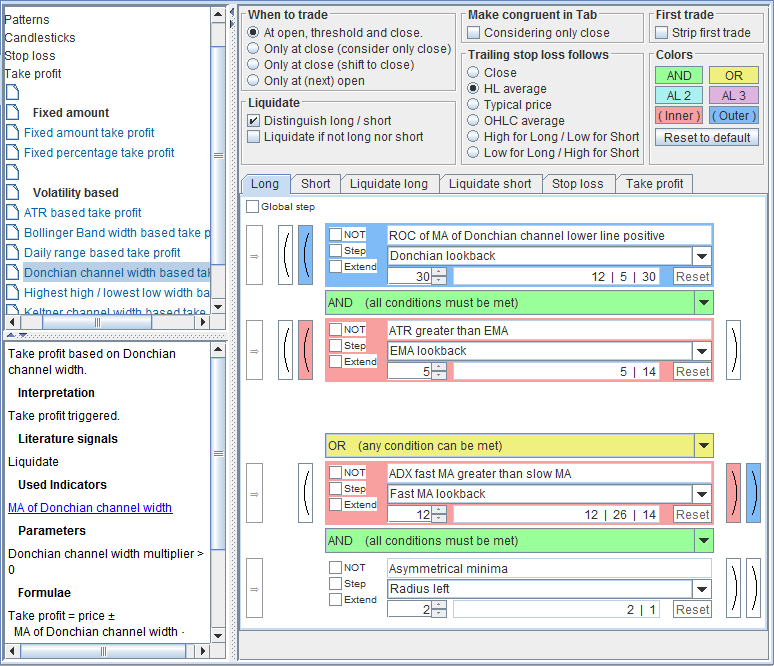
Select the Composer tab
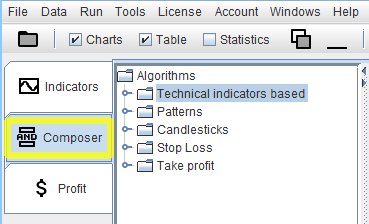
In the main window of Trading Conceiver, select the tab
Composer
Sections
Here are the main sections of the Composer user interface: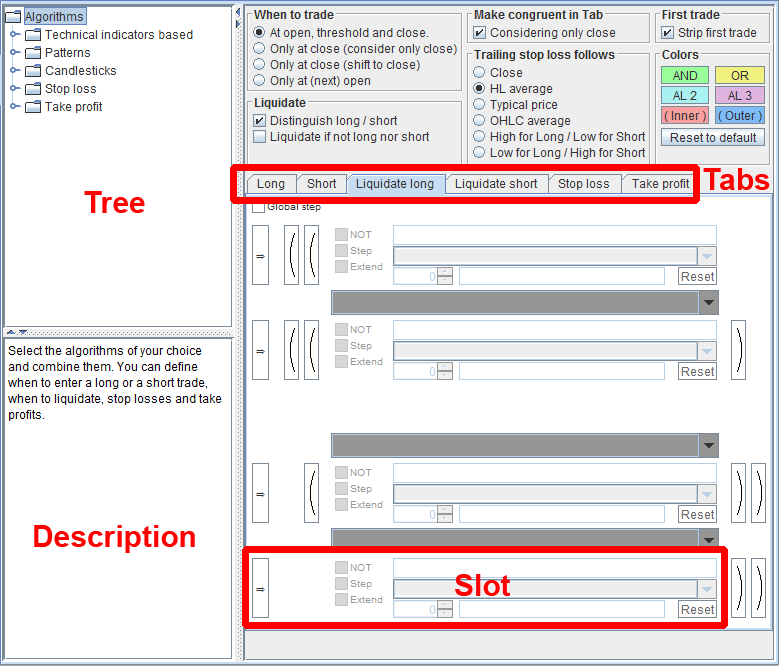
The Composer Tree
The list of implemented algorithms is presented in a tree-like structure. To expand or collapse a branch, either double click on it or click on its handle.Tree's Branches
The tree has the following main branches:- Technical indicators based
Algorithms based on technical indicators. You can find the corresponding indicators in theIndicatorstab. - Patterns
Algorithms based on pattern recognition. - Candlesticks
Algorithms based on candlestick pattern recognition. - Stop Loss
Algorithms to be used as stop loss. - Take profit
Algorithms to be used as take profit.
The Technical indicators based Sub-Branches
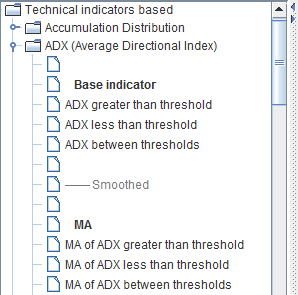 For the definition of base indicator and derived indicator, please see the
For the definition of base indicator and derived indicator, please see the Indicators section of the user manual.
The Technical indicators based branch is further divided into branches.
Each branch correspond to a base indicator.
In each of these sub-branches, there is the list of elementary trading algorithms dependent on such base indicator and its derived indicators.
Multi-Curve Indicators
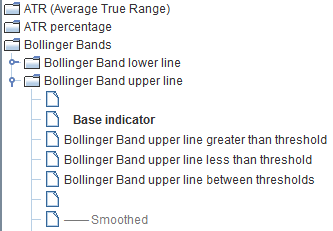 To render the elementary trading algorithms more standardized, for those indicators consisting of more than one significant curve,
the algorithms are further divided into sub-branches, one sub-branch for each curve.
A typical example are channels and bands indicators, like the Bollinger Bands, the Keltner Channels and so on.
They have a branch for the lower line and another branch for the upper line.
Another example is the ADX in its ±DI forms.
To render the elementary trading algorithms more standardized, for those indicators consisting of more than one significant curve,
the algorithms are further divided into sub-branches, one sub-branch for each curve.
A typical example are channels and bands indicators, like the Bollinger Bands, the Keltner Channels and so on.
They have a branch for the lower line and another branch for the upper line.
Another example is the ADX in its ±DI forms.
Intraday Algorithms
Algorithms operating not only at Close, but also intradaily, appear in blue, to make them readily recognizable.Select an Algorithm
By expanding the branches, at the end the leaves are found, where the actual algorithms lie. To select an algorithm, click on it. Some leaves are left empty, for readability purposes. Other leaves contain titles or dividers, again for improved readability.Collapse the Whole Tree
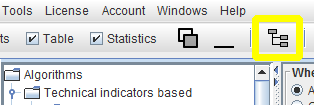 After a while you could find to have expanded a lot of branches and want to collapse the whole tree.
In order to do that, click on the tree icon in the main tool-bar.
After a while you could find to have expanded a lot of branches and want to collapse the whole tree.
In order to do that, click on the tree icon in the main tool-bar.
Resize the Tree Pane
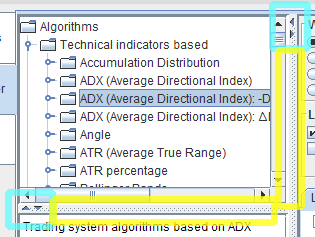 You can resize the tree pane, vertically or horizontally, by dragging the dividers on its sides.
You can even collapse the whole pane containing the tree, vertically or horizontally, by clicking on the small arrows of the dividers;
to expand it, click on the arrows again.
You can resize the tree pane, vertically or horizontally, by dragging the dividers on its sides.
You can even collapse the whole pane containing the tree, vertically or horizontally, by clicking on the small arrows of the dividers;
to expand it, click on the arrows again.
The Description Pane
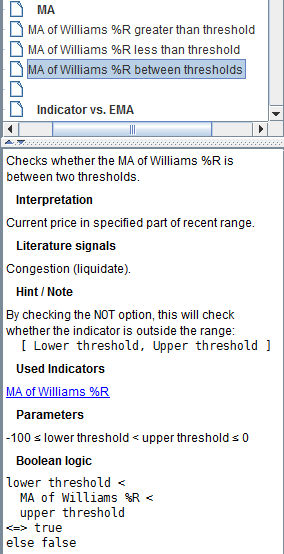 When you select an algorithm, a brief description of it appears in the description pane, at the bottom.
When you select an algorithm, a brief description of it appears in the description pane, at the bottom.
Introduction / Definition
A brief introduction or definition comes first.Interpretation
Here you can find how to interpret the algorithm. The interpretation can stem from the indicator per se or from the trading algorithm. If it depends on the algorithm, you will find similar interpretation for the same algorithm, independently from the indicator. On the other hand, if it depends on the indicator, it is based on literature. In this case, we stress that these are just notes about what you can find in the literature. Do not stick to it! The real interpretation is up to you.Literature Signals
This is what literature usually says about the phase of the market implied by the indicator, like uptrend, downtrend or congestion. Do NOT rely on the signals listed here! Decisions are up to you! These are only notes / remainders of what you can find in bibliography. Any decision is legitimate, even the exact opposite of what is reported by reputable authors. Moreover, a single indicator seldom can give reliable signals; these must always be confirmed by other indicators.Hint / Note
Here some notes might be reported.Used Indicators
All algorithms depend on indicators. Those indicators are pointed out here, in form of links. Click the link to go to the description of the relevant indicator, in theIndicators tab.
Parameters
Most algorithms require input parameters from the user. If the meaning or range of such parameters is not readily clear from the description or from the formulae, some elucidation could be reported in this section. Usually, it is not reported for the lookback period, because it is trivial.Boolean logic
The Boolean logic states the conditions under which an algorithm is true.The Tabs
There are 6 tabs:- Long
Here you specify when to go long. - Short
Here you specify when to go short. - Liquidate long
Here you specify when to liquidate the long position. - Liquidate short
Here you specify when to liquidate the short position. - Stop loss
Here you specify the stop loss. - Take profit
Here you specify the take profit.
Long, Short and Liquidate Tabs
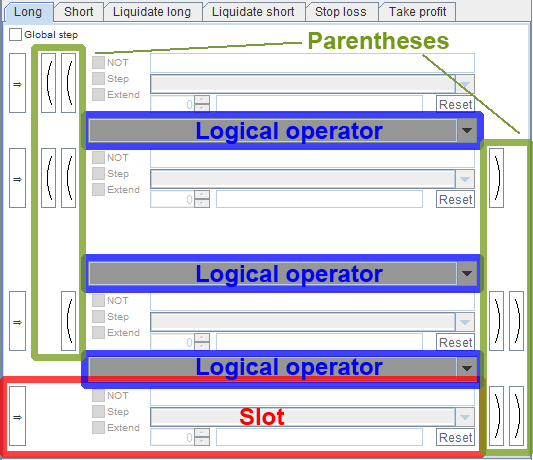 Each tab consists of the following.
Each tab consists of the following.
Slots
Four slots, similar to those of the indicators. Here you put the elementary trading algorithms you want to consider.Logical Operators
Here you select how to combine the elementary trading algorithms, by selecting the logical operator between them. The logical operators are:- AND
All conditions must be met. - OR
It is enough that just one condition is met. - At least 2
At least 2 conditions must be met. - At least 3
At least 3 conditions must be met.
Parentheses
Through the use of parentheses you assert the precedence order in which the logical operators are calculated. If the parentheses are unmatched, a warning is issued.Global step
By selecting this checkbox, you consider the whole tab boolean logic to be true only when it switches from false to true.Stop Loss and Take Profit Tabs
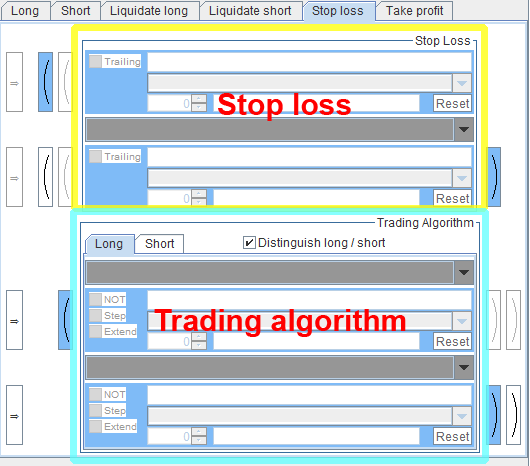 The stop loss and take profit tabs are very similar to the one described.
However, they are divided into two sections.
The top section is dedicated to the stop loss (or take profit) algorithms.
You can put in here only the algorithms in the
The stop loss and take profit tabs are very similar to the one described.
However, they are divided into two sections.
The top section is dedicated to the stop loss (or take profit) algorithms.
You can put in here only the algorithms in the Stop loss (or Take profit) branch of the tree.
These are the 'real' stop loss (take profit) algorithms.
The bottom section is dedicated to the 'standard' elementary trading algorithms, the ones found in the following branches of the tree:
- Technical indicators based
- Patterns
- Candlesticks
Long ShortThe stop loss (take profit) algorithms are combined with the
Long tab when a long position is under way,
and with the Short tab when a short position is opened.
If you don't want to distinguish between long and short trades, deselect the checkbox
Distinguish long / shortIn this case, only one tab is enabled, both for long and short positions.
Non-Empty Tabs
 If a tab has at least one slot filled in, a graphical dot is added near its name.
This is to have a clear and immediate view of which tabs are being used, because they contain at least one algorithm.
Empty tabs do not have the dot.
If a tab has at least one slot filled in, a graphical dot is added near its name.
This is to have a clear and immediate view of which tabs are being used, because they contain at least one algorithm.
Empty tabs do not have the dot.
The Slots
 Each slot consists of the following.
Each slot consists of the following.
The Selection Buttons
When you press the selection button, the correspondent slot is filled in with the algorithm selected in the tree. This way the algorithm is effectively selected. These buttons are enabled only when the right branch (or sub-branch or leaf) in the Composer Tree is selected. For instance, if a stop loss is selected in the tree, only the top two buttons in the stop loss tab are enabled. So, first select the algorithm of your choice in the tree, then press one of the selection buttons to put it in the corresponding slot.Algorithm Name
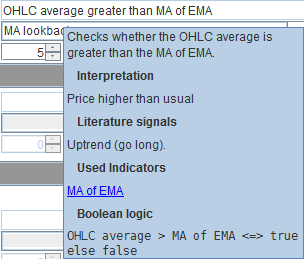 The algorithm name is shown on top. If you hover the mouse over it, the description of the algorithm is shown as a tooltip.
The algorithm name is shown on top. If you hover the mouse over it, the description of the algorithm is shown as a tooltip.
Combobox
 Input parameters are given default values just for convenience. Do not rely on those. Choose your own.
To choose the value for an input parameter, first select it through the combobox.
Input parameters are given default values just for convenience. Do not rely on those. Choose your own.
To choose the value for an input parameter, first select it through the combobox.
Spinner
After selecting the input parameter in the combobox, you can choose its value thorough the spinner. You can input the new value manually, and then pressing the 'Enter' key. Or you can increment / decrement the value by pressing the up / down arrows, respectively. If the number is an integer, the increment is by 1. If the number is a floating-point number, the increment is by 0.1. The spinner makes sure some constraints are satisfied, like the lower and upper bounds for each parameter. Usually you can find such bounds in theParameters section of the description.
You cannot input values colliding with the constraints.
Input Parameters Values
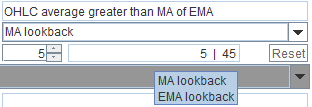 In this text-field you can see all the input parameters.
If you hover the mouse over this field, a tooltip with the names of the input parameters appears.
The order is the same as in the combobox.
In this text-field you can see all the input parameters.
If you hover the mouse over this field, a tooltip with the names of the input parameters appears.
The order is the same as in the combobox.
Reset Button
Press theReset button to clear the slot.
Checkboxes
Checkboxes, associated to each slot, change the behavior of the algorithm. Trading algorithms have the following checkboxes:- NOT
This inverts the boolean logic, transforming true in false and vice versa. - Step
This changes the boolean logic to be true only when it switches from false to true. - Extend
This 'extends' the close value, making it valid even for the next open and intraday.
- Trailing
If checked, the stop loss is trailing, i.e. 'follows' the price.
The Intraday Label
For algorithms operating not only at Close, but also intradaily, an 'i' appears, signaling that.
When to Trade Radio Buttons
 Through these radio buttons, you can decide when to trade:
Through these radio buttons, you can decide when to trade:
- At open, threshold and close
Trading signals are given at open, intradaily and at close. This is the most powerful, but also the most complicated. - Only at close (consider only close)
Calculations are made only at close. - Only at close (shift to close)
Calculations are made intradaily, but trading signals are given only at close. - Only at (next) open
Calculations are made intradaily, but trading signals are given only at open.
Liquidate Checkboxes

Distinguish Long and Short Positions
When the checkboxDistinguish long / shortis checked, you can use different algorithms for liquidating a long or a short position. Both the
- Liquidate long
- Liquidate short
Create Liquidate Automatically
If you want to specify only when to go long and short, implying that when neither the tabLong nor the tab Short are true,
it means to liquidate the position, you can select the checkbox
Liquidate if not long nor shortThis will create, internally, a liquidate condition, which is true whenever the tabs
Long and Short are both false.
In this case, both the liquidate tabs are disabled.
Make congruent in tab Checkbox
 If a trading algorithm operates only at close, it means that at open and at threshold it is undefined.
When combining it, within the same tab, with an algorithm that is defined even at open and threshold, this checkbox selects how to make them congruent:
If a trading algorithm operates only at close, it means that at open and at threshold it is undefined.
When combining it, within the same tab, with an algorithm that is defined even at open and threshold, this checkbox selects how to make them congruent:
- Checked
Only close is considered. - Unchecked
The algorithm operating even at open and threshold is modified, so that all signals are 'shifted' from open and threshold to close.
Trailing stop loss follows Radio Buttons
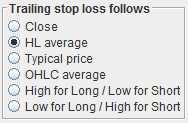 Trailing stop loss algorithms follow the price. Here you can select exactly what price:
Trailing stop loss algorithms follow the price. Here you can select exactly what price: - Close
This is the standard in literature.
- HL average
The average between high and low:high + low HL average = ──────────── 2
- Typical price
The average between high, low and close:high + low + close Typical Price = ──────────────────── 3
- OHLC average
The average between open, high, low and close:open + high + low + close OHLC Average = ─────────────────────────── 4
- High for Long / Low for Short
That is high price for long positions and low price for short positions.
- Low for Long / High for Short
That is low price for long positions and high price for short positions.
Strip first trade Checkbox
 It can happen that boundary conditions to be different on the very first trade, resulting in unexpected behavior for the very first trade.
If you identify such an eventuality, by selecting this checkbox the first trade is deleted.
It can happen that boundary conditions to be different on the very first trade, resulting in unexpected behavior for the very first trade.
If you identify such an eventuality, by selecting this checkbox the first trade is deleted.
Colors
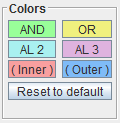 Here you can customize colors used in the Composer user interface.
The ones used for logical operators:
Here you can customize colors used in the Composer user interface.
The ones used for logical operators:
- AND
- OR
- At least 2
- At least 3
- Inner parentheses
- Outer parentheses
Reset to defaultresets the colors to their default value.
Disambiguate
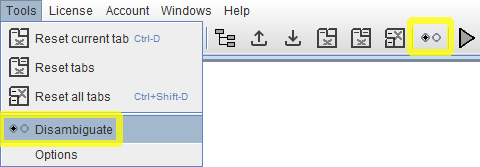 Selecting the menu
Selecting the menu
Tools → Disambiguateor clicking the homonymous icon in the main tool bar, a new window opens.
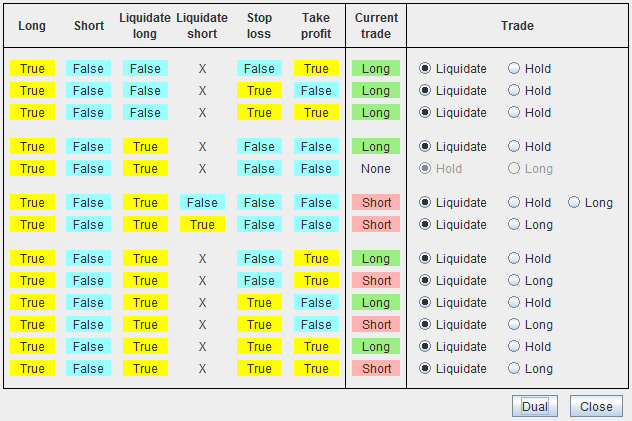
Here you can decide what to do in ambiguous cases. Ambiguous cases arise because the logic in the various composer tabs (long, short, liquidate...) is not mutually exclusive. Meaning that two or more tabs can be true simultaneously. As an example you might be holding a long position and have:
Current position : long Long tab : true Stop loss tab : trueThey are two contradictory signals. The stop loss is telling you to liquidate the long position, but the long signal is telling you to go long. So you could either liquidate or hold the long position. Both alternatives are legitimate. In the ambiguous window you can select the action to take in such cases. Press the radio button corresponding to your choice. An
X in the table means 'don't care'.
Dual
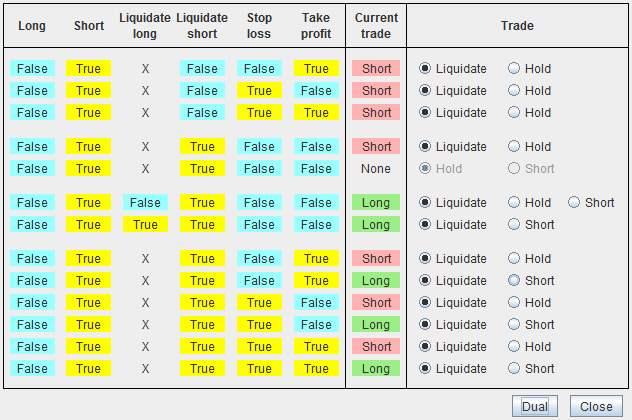
Dual cases are those that can be inferred. For instance, in the example above, the dual case would be
Current position : short Short tab : true Stop loss tab : trueThey are symmetrical cases and the ambiguity in both cases is the same. Either you liquidate or hold the position. Once you make a decision of what to do, that decision is the same for both events. For this reason, the window contemplates only the strictest number of cases. If you want to see their dual, press the button
Dual
Save and Load the Configuration
Save
 You can save the configuration both for the Indicators and Composer panels, together.
You can save the configuration both for the Indicators and Composer panels, together.
What Is Saved
All the graphical controls are saved, the slots (the selected algorithms, their input parameters, the horizontal levels for the indicators), logical operators, parentheses, and all other radio buttons, checkboxes... in the Indicators and Composer panes.The only exceptions are the colors for the Composer and the import file for the Indicators. The latter is motivated by the fact that the imported waveform is supposed to be used only temporarily, and that it will be probably deleted shortly afterwards. So it is likely to not exist any more in the future, when loading the configuration again, and that would cause a warning.
How to Save
Either select the menu itemFile → Save configurationor click the homonymous icon in the main tool bar. In the pop-up window, choose an appropriate directory and file name.
Extension
The file extension is the part of the name of the file coming after the last dot ('.'). When saving the file, an extension to the file is added automatically. By default, the file extension is.composerbut you can customize it in
Tools → Options → ExtensionsOnly files with such an extension are shown. To see all the files, regardless of the extension, in the pop-up window select:
Files of Type: All FilesTo confirm saving, press the
Save button in the pop-up window.
Load
 To load a saved configuration, valid for both the Indicators and the Composer panels, together, either select the menu
To load a saved configuration, valid for both the Indicators and the Composer panels, together, either select the menu
File → Load configurationor click the homonymous icon in the main tool bar.
Extension
Again, in the pop-up window, only files with the appropriate extension are shown; see the previous paragraph for details. Select one of the files you saved before and confirm loading by pressing theOpen button.
Reset the Tabs
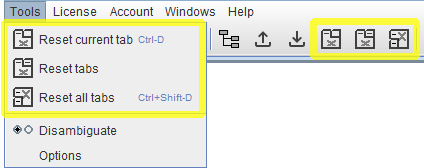
Reset Current Tab
To reset only the current tab (Long, Short, Liquidate long, Liquidate short, Stop loss, Take profit) select the menuTools → Reset current tabor click the homonymous icon in the main tool bar.
Reset Tabs
To reset all the tabs in the Composer (Long, Short, Liquidate long, Liquidate short, Stop loss, Take profit) select the menuTools → Reset tabsor click the homonymous icon in the main tool bar.
Reset All Tabs
To reset all the tabs both in the Composer pane (Long, Short, Liquidate long, Liquidate short, Stop loss, Take profit) and in the Indicators pane (Chart, Table) select the menuTools → Reset all tabsor click the homonymous icon in the main tool bar.
